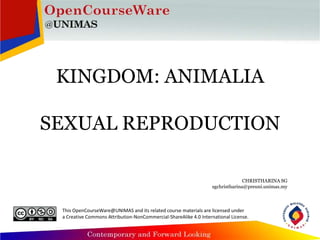
Ocw [animal reproduction]
- 1. This OpenCourseWare@UNIMAS and its related course materials are licensed under a Creative Commons Attribution-NonCommercial-ShareAlike 4.0 International License. KINGDOM: ANIMALIA SEXUAL REPRODUCTION CHRISTHARINA SG sgchristharina@preuni.unimas.my
- 2. http://farm9.staticflickr.com/8448/7991284064_9281a6e1f4_z.jpg 1. Differentiate between internal and external fertilisation 2. Differentiate the three types of embryos’ development 3. Briefly describe the mating behaviour and the reproductive organs involved Learning Objectives:
- 3. Fertilization can be internal or external Animals can be grouped into three categories based on the embryonic development: 1. Oviparity 2. Viviparity 3. Ovoviviparity http://farm4.staticflickr.com/3444/3268077745_fd24bd675f_z.jpg
- 4. External vs Internal Fertilisation EXTERNAL INTERNAL Sperms cell unites with the egg cell outside the female body Sperms are deposited in or near reproductive tract and the union takes place within the female body Environmental cues and body chemicals such as pheromones ensure sperms and eggs released at the same time and in close proximity Requires complementary mating behavior and reproductive organs between the two sexes. Characteristics of aquatic animals such as coral, Hydra, fish and amphibians (frogs, toads) Characteristic of salamander (amphibian), reptiles, birds and mammals (higher vertebrates) Large numbers of eggs but low survival rate Small numbers of eggs but high survival rate Massive zygotes Fewer zygotes Lack/No parental care Parental Care High number of gametes Low number of gametes Eggs lack of covering; jelly like membrane for amphibian Amniotic eggs were covered with calcareous shells
- 5. EXTERNAL INTERNAL Sperms cell unites with the egg cell outside the female body Sperms are deposited in or near reproductive tract and the union takes place within the female body
- 6. Environmental cues and body chemicals such as pheromones ensure sperms and eggs released at the same time and in close proximity Requires complementary mating behavior and reproductive organs between the two sexes. A Male and Female common frog in amplexus. The purpose of amplexus is to ensure the male is in the optimal position to fertilize the female’s eggs as she lays them. Foam nest
- 7. Massive zygotes Fewer zygotes Frogspawn
- 8. High number of gametes Low number of gametes Fish gametes Frog gametes
- 9. Lack/No parental care Parental Care Exception!! A female frog that swallows its eggs or carrying on the back to protect them. A female salamander (amphiumas) coiled around her nest to protect the egg from predators egg Where is mommy and daddy?
- 10. Parental care is a diagnostic character for aves and mammals http://mariannedenazareth.blogspot.com/2011/08/parental-care.html http://www.dreamstime.com/stock-photography-parental-care-image8250792
- 11. Oviparity Ovoviviparity Viviparity Lay eggs Eggs developed in female’s body until hatch Live birth Development of the embryos in female’s body External and internal fertilization Internal fertilization Internal fertilization No nutrition is provided to the developing embryo except for egg’s yolk The embryo obtains its nutrients and oxygen from the female via placenta. After live birth the young can survive with the supervision from its mother The embryos of animals undergo three types of development as below:
- 12. Oviparity https://i.ytimg.com/vi/ihaR-_SDemE/maxresdefault.jpg http://www.findaspider.org.au/find/spiders/images/SalticidInsectEggs.jpg Yolk in the eggs provides nutrients that will sustain development of the young.
- 13. http://www.bio.gc.ca/sharks/images/reproduction-fig14.jpg Viviparity Ovoviviparity http://askwhy.co.uk/dinosauroids/wp-content/uploads/2012/03/snake_live_birth.jpg The mother gives birth to young that recently hatched in her body. The young were nourished by egg yolk, not by their mother. Embryo are nourished by the placenta; the organ which allows nutrients from the maternal blood to diffuse to the embryo, and expelled at birth.